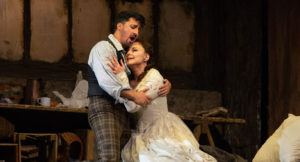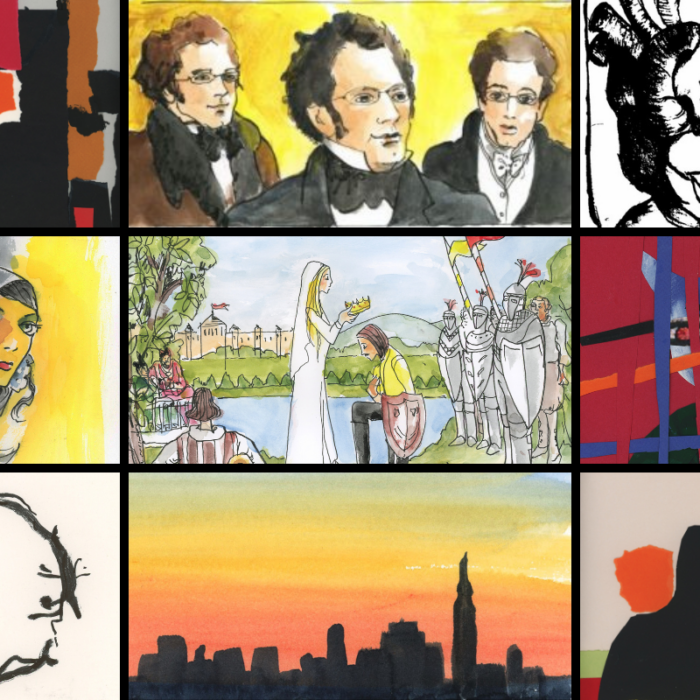
Metropolitan Opera 2021-22 Review: La Bohème
Anita Hartig & Artur Rucinski Shines in Mixed Bag Performance
By David SalazarOn Nov. 17, 2021, the Metropolitan Opera presented the third performance of its 2021-22 run of Puccini’s seminal “La Bohème.”
Franco Zeffirelli’s production is celebrating its 40th anniversary and is arguably the company’s most iconic. There was something quite uplifting about seeing the curtain rise on this expansive set, brimming with life and energy, especially after the time period we all lived through. The audience enthusiasm added to this, with the customary applause for Act two’s opening moments more effusive than ever.
With this energy in store, one hoped that the overall execution of this famed work would meet it. However, the result was a mixed bag.
Mixed Bag
In the pit was conductor Eun Sun Kim, who has taken the opera world by storm after becoming the Music Director of the San Francisco Opera. This run of performances represent her Met debut, which is one of many similar maiden appearances at opera houses around the world. Unfortunately, her work in this performance of Puccini’s most iconic and beloved work left a lot to be desired.
Things got off to a solid start during the evening with the first few ensembles tight, focused, and moving along swiftly. But things start to come apart the moment Rodolfo and Mimì’s big Act one scene started. For one, the orchestra’s thick texture, which had been noticeable to that point, became overly prominent, essentially shutting down tenor Charles Castronovo’s ability to make much of his famed “Che gelida manina.” From the orchestra seats, it was hard to hear the tenor and when you did, it sounded like he was fighting against the larger ensemble. Things got more difficult during Mimì’s “Mi chiamano Mimì” where hesitancy and disconnect crept into the orchestral playing. A lot of confusion crept in during the Andante Calmo section that starts with “Mi piaccon quelle cose,” where the orchestra syncopations were way off from what soloist Anita Hartig was doing. We saw similar sloppiness throughout Act two, including the opening ensemble (which resulted in a lack of clarity from some soloists), the ensemble following “Quando m’en vo,” and the final marching band, which was started completely off beat from the orchestra.
Things did tighten up in the third Act and even more so in the fourth Act (the duet between Marcello and Rodolfo to kick off the Act might have been the musical highlight of the evening in terms of soloist-orchestral cohesion) but hesitancy seemed to creep up here and there between the large ensemble and the singers. This was most apparent during Colline’s famed “Vecchia zimarra, senti” where there was a clear disconnect between singer and conductor that never allowed the piece to take off musically or emotionally.
Sloppiness aside, Kim’s interpretation tended toward the repetitive in some instances, particularly with her penchant for an overemphasis on rubato transitions which had the cumulative effect of making the piece feel increasingly lethargic and plodding. At times, there was even choppiness in the phrasing during these transitions. One example I couldn’t shake was the transition to the callback to the “Soave fanciulla” melody in Act four (marked Più sostenuto in the score) once Schaunard has exited the loft. Puccini calls for a rallentando that climaxes in a D major chord pickup into the melody. The way the music was performed, that pickup chord sounded like it was on an island on its own. There is an eighth rest right before the pickup note, but there is none after it as it leads right into the melody; the Riccordi orchestral score has a slur connecting that pickup with the ensuing phrase. Without that connection to the next note, the overemphasis on the lone pickup chord as part of a continued rallentando chops up the phrase. And throughout the rest of the work, there were similar slowdowns at major transition points. If you didn’t know we were getting ready for another scene or number, the drawn-out rallentandos would cue you in.
Complementary Bohemians
As Schaunard and Colline, Alexander Birch Elliott and Nicholas Brownlee made a complementary pair. Where Elliott’s Schaunard was bouncy and lively, Brownlee’s Colline was more rugged and grounded. There’s a moment in Act two in which Rodolfo presents Mimì to his friends and Schaunard talks about his approval; given the playful nature of Elliott’s Schaunard, this moment came off as mischievous and led to a subtle tension with Charles Castronovo’s Rodolfo that freshened up the scene. Meanwhile, Brownlee’s Colline was far gentler in his demeanor, something most beautifully exhibited in the final scene of the opera when he walked over to Rodolfo and gently tapped his shoulder in solidarity before the news broke of Mimì’s death. You could hear this differentiation vocally between the two with Elliott’s singing tending to be more flighty (and unfortunately often covered up by the orchestra in his middle register), while Brownlee managed a very firm and round sound that projected quite well into the orchestra. As mentioned, his big moment didn’t quite work out so well due to some hesitancy, but his other work throughout the evening worked quite well toward building out the quartet.
In the role of Musetta, Federica Lombardi had a solid evening. She possesses a potent and round sound that easily projects into the Met’s massive auditorium. And moreover, she does so with a sense of technical firmness. There are a few eighth note runs up to a high B flat shortly after her entrance that a lot of sopranos struggle to settle into; Lombardi dispatched them with ease and fluidity. The same can be said for the iconic “Quando m’en vo,” which displayed a polished legato line and beautiful connection between her registers. However, a lot of this vocal connection did come at the expense of consonants, which can make it tough to make out the words she’s singing at times. And given how familiar this opera is to most listeners, it’s hard to overlook this fact. In the latter part of the opera, Puccini gives Musetta more parlatto lines, which came across far clearer and worked to Lombardi’s advantage; she was particularly effective in the fourth act in this regard.
Wide-Ranging Color Palette
Artur Rucinski was a standout in the role of Marcello for a number of reasons. Vocally, he’s the complete package and his trademark long phrase singing (where he omits usual breaths) was on full display. It’s an impressive bit of vocal virtuosity, but it’s not just for show; it allows for vocal lines to attain a certain level of fluidity and polish, especially when it comes off as so easy (which it isn’t). His standout moment definitely came at the top of Act four during the duet with Rodolfo, his voice shifting from potent and free to more withdrawn and intimate.
As the painter Marcello, it was refreshing to hear a vast vocal palette for him. He had a drier and rougher texture during the second Act as he denounced love and a very coarse quality when fighting with Musetta in the third Act. There was a clear vocal contrast in his interaction with Mimì and Rodolfo in their back-to-back scenes of Act three; he had a smoother tone as he tried to smooth things out with Mimì before shifting into a more sardonic tone with Rodolfo in the ensuing moment. And after all this, the moment he heard Musetta laughing, his voice took on a nasally quality that imbued the sense of a jealous and insecure lover. In Act four, Rucinski altered his voice into a pitchy squeal during the fun and games section of Act four.
And this kind of musical detail work translated to his characterization of Marcello. There are a few moments that stood out because I don’t believe anyone has attempted them in previous iterations of this production. As Musetta goes around singing her big solo, Rucinski’s Marcello grabbed a paper and board and started drawing a subject, ignoring her as much as he could, until he couldn’t. And at the top of Act four, right before the duet with Rodolfo, he threw his paint supplies aside in fury; the subsequent crash made you feel his frustration. But what happened next added so much to the moment – he bent over and gently picked it up. It was a reflection of his mixed feelings toward his lost love. On one hand, he can’t stand her, but on the other, he can’t be without her.
We got a lot of this push-pull dynamic within that relationship, which really brought it to life. At times, his Marcello came off as a bit aggressive, only to back off and seemingly realize his transgressions. This was most aptly expressed at the end of the third Act, where after all the fighting with Musetta and calling her a “Stregha,” Marcello ran into the inn for cover. But moments later, he exited and ran after her. Again, this was an inspired staging choice I hadn’t seen or noticed before. And in the final Act, he went from shushing Musetta and his friends to being more contrite as he caressed her face. I often feel that a lot of iterations of this production aim to bring forth a reconciliation between the two by the end, as if pain of loss will be enough to get them through the hard times. And often times it seems that this reconciliation comes about because Musetta has learned the error of her ways and has finally learned to appreciate the kind, Marcello. But Rucinski’s portrayal added more depth and complexity to the relationship, making us realize that this bohemian is anything but a hero waiting to be appreciated. He too bears the responsibility for their relationship not working.
Explosive Tenor
Tenor Charles Castronovo’s Rodolfo was a hothead who seemed to reel at any mere slight. He seemed ready to punch Schaunard for his comment about “approving” of Mimì and then later seemed ready to come to blows with Marcello for being called out on the truth. The grabbing of the chair in the first Act to smash at Benoit never felt more real. This intense emotionality in his portrayal developed over the course of the story and really came to full fruition in the final act. The final moment of the opera, when he realizes the truth might have been the most visceral and real of the night. After closing the curtains, he turned and saw Schaunard muttering something to Colline. Immediately he turned to find Marcello approaching, his three friends essentially surrounding him and growing closer. Again, he seemed ready to punch someone, before Marcello wrapped his arms in a hug that Castronovo’s Rodolfo wanted nothing to do with. He eventually broke free after the first “Mimì” only to wrap his arms around his dead lover, ending the opera on a very violently emotional beat.
The tenor grew into the role vocally throughout. He got off to a shaky start with his high notes a bit edgy and uneven in the opening lines; he seemed to come alive with the proclamation of “Eureka!” Things steadied throughout the first Act until his big aria, where as noted, he struggled to project and when he did, it was through pushing his high notes. The famed High C, unfortunately, didn’t quite flourish and by the end of the duet “O soave fanciulla,” his voice sounded a bit taxed and overpowered by soprano Anita Hartig.
Act two saw the tenor slowly starting to round into form; this role features a lot of work in the tenor’s upper range, something that proved a bit of a mixed bag for Castronovo. He possesses a stentorian squillo which undeniably works wonders in more dramatic and tragic, but also lacks in color and could appear rather monotonous everytime he had to hit a higher note. You could almost predict every sound, stripping the overall interpretation of nuance and variety for much of the first two Acts. He definitely put this steely and pained squillo to great use in the third and fourth Acts where Rodolfo’s desperation is allowed to come to the fore with greater emphasis. He particularly shone alongside Hartig in “Dunque è propio finita!” as the two managed to stick together phrase for phrase, almost as if one voice.
The same could be said for his work with Rucinski in the Act four quartet where the tenor managed to add in some piano singing in his upper range, seemingly expanding the vocal color palette for the first time on the evening, something that he continued to explore throughout the remainder of the Act, especially during “Sono andati?” His final cries of “Mimì! Mimì” were definitely in his vocal wheelhouse and one could feel that he put everything he had left into delivering those pained cries.
Sense of Self to the End
Next to Rucinski, Hartig was the vocal standout on the evening as “Mimì.” There was a graininess and edge to her sound that grounded the character. She was gentle throughout the opening “Mi chiamano Mimi,” navigating the aforementioned lack of musical coordination quite well and never seeming flustered or lost throughout the opening stanzas of the aria. But she really found some musical inspiration in the vocal line preceding “Ma quando vien lo sgleo.” The “in cielo” rallentando was delivered as a gentle diminuendo that slowly faded into nothing. It was a sublime transition and set up for one of the lushest lyrical moments of the opera. And after that tender descrescendo, Hartig made the most of “Ma quando vien lo sgelo,” her singing one growing wave after another, sustaining the high A’s as if a person clinging for dear life, allowing the listener to hear Mimì’s passionate nature for the first time. She was similarly intense throughout the duet, climaxing the Act on a generously held high C.
Act three was another standout moment for Hartig, her voice soaring over the orchestra at the climaxes of “Rodolfo m’ama e mi fugge.” But I might have to nominate “Donde lieta usci” as the standout vocal moment of the evening. Hartig’s singing here was multi-dimensional, straddling tenderness, pain, heartbreaking, and, at its climax, passionate. But unlike the more granular sound and intensity we heard at the climaxes of “Ma quando vien lo sgelo,” the vocal color was brighter and smoother; it was almost transcendent, Mimì almost finding some enlightenment in this gentle goodbye.
In Act four, a lot of modern singers imbue their singing in this act with a breathiness that furthers the feeling of Mimì’s impending death. Sometimes it works, sometimes it’s a distraction. Hartig found a solid middle ground, her singing taking on an even lighter texture, her sound almost always piano, emphasizing Mimì’s fading health. But it retained its fullness, just as Mimì retains her sense of self to the very end.
All in all, this was the third performance of an extensive run of a highly popular opera. It will be interesting to see how this ensemble evolves over the coming weeks.
Categories
News

